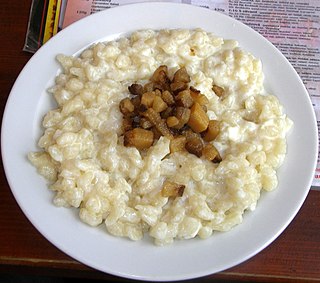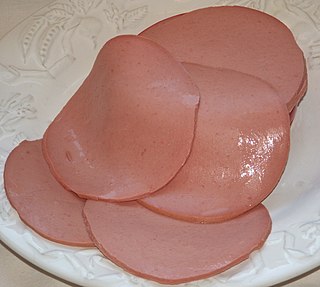
Midwestern cuisine is a regional cuisine of the American Midwest. It draws its culinary roots most significantly from the cuisines of Central, Northern and Eastern Europe, and Native North America, and is influenced by regionally and locally grown foodstuffs and cultural diversity.

A sausage is a type of meat product usually made from ground meat, often pork, beef, or poultry, along with salt, spices and other flavourings. Other ingredients such as grains or breadcrumbs may be included as fillers or extenders.

A hot dog is a food consisting of a grilled or steamed sausage served in the slit of a partially sliced bun. The term hot dog can also refer to the sausage itself. The sausage used is a wiener or a frankfurter. The names of these sausages also commonly refer to their assembled dish. Some consider a hot dog to technically be a sandwich. Hot dog preparation and condiments vary worldwide. Typical condiments include mustard, ketchup, mayonnaise, relish, and cheese sauce, and common garnishes include onions, sauerkraut, jalapeños, chili, grated cheese, coleslaw, bacon, and olives. Hot dog variants include the corn dog and pigs in a blanket. The hot dog's cultural traditions include the Nathan's Hot Dog Eating Contest and the Oscar Mayer Wienermobile.

A blood sausage is a sausage filled with blood that is cooked or dried and mixed with a filler until it is thick enough to solidify when cooled. Most commonly, the blood of pigs, sheep, lamb, cow, or goose is used.

A fried egg is a cooked dish made from one or more eggs which are removed from their shells and placed into a frying pan and fried with minimal accompaniment. Fried eggs are traditionally eaten for breakfast in many countries but may also be served at other times of the day.

Chorizo is a type of pork sausage originating from the Iberian Peninsula.

Meatloaf is a dish of ground meat that has been combined with other ingredients and formed into the shape of a loaf, then baked or smoked. The final shape is either hand-formed on a baking tray, or pan-formed by cooking it in a loaf pan. It is usually made with ground beef, although ground lamb, pork, veal, venison, poultry, and seafood are also used, sometimes in combination. Vegetarian adaptations of meatloaf may use imitation meat or pulses.

Lunch meats—also known as cold cuts, luncheon meats, cooked meats, sliced meats, cold meats, and deli meats—are precooked or cured meats that are sliced and served cold or hot. They are typically served in sandwiches or on a tray. They can be purchased pre-sliced, usually in vacuum packs, or they can be sliced to order.

Austrian cuisine is a style of cuisine native to Austria and composed of influences from Central Europe and throughout the former Austro-Hungarian Empire. Austrian cuisine is most often associated with Viennese cuisine, but there are significant regional variations.

A schnitzel is a thin slice of meat. The meat is usually thinned by pounding with a meat tenderizer. Most commonly, the meat is breaded before frying. Breaded schnitzel is popular in many countries and is made using veal, pork, chicken, mutton, beef, or turkey. Schnitzel is very similar to the dish escalope in France, tonkatsu in Japan, cotoletta in Italy, kotlet schabowy in Poland, milanesa in Argentina, chuleta valluna in Colombia and "chicken fried steak" of the United States.

Slovak cuisine varies slightly from region to region across Slovakia. It was influenced by the traditional cuisine of its neighbours and it influenced them as well. The origins of traditional Slovak cuisine can be traced to times when the majority of the population lived self-sufficiently in villages, with very limited food imports and exports and with no modern means of food preservation or processing.

Charcuterie is a French term for a branch of cooking devoted to prepared meat products, such as bacon, ham, sausage, terrines, galantines, ballotines, pâtés, and confit, primarily from pork.

Czech cuisine has both influenced and been influenced by the cuisines of surrounding countries and nations. Many of the cakes and pastries that are popular in Central Europe originated within the Czech lands. Contemporary Czech cuisine is more meat-based than in previous periods; the current abundance of farmable meat has enriched its presence in regional cuisine. Traditionally, meat has been reserved for once-weekly consumption, typically on weekends. The body of Czech meals typically consists of two or more courses; the first course is traditionally soup, the second course is the main dish, and the third course can include supplementary courses, such as dessert or compote. In the Czech cuisine, thick soups and many kinds of sauces, both based on stewed or cooked vegetables and meats, often with cream, as well as baked meats with natural sauces (gravies), are popular dishes usually accompanied with beer, especially Pilsner, that Czechs consume the most in the world. Czech cuisine is also very strong in sweet main courses and desserts, a unique feature in European cuisines.

Barbecue varies by the type of meat, sauce, rub, or other flavorings used, the point in barbecuing at which they are added, the role smoke plays, the equipment and fuel used, cooking temperature, and cooking time.

Bologna sausage, also spelled baloney, is a sausage derived from mortadella, a similar-looking, finely ground pork sausage containing cubes of pork fat, originally from the Italian city of Bologna. Typical seasoning for bologna includes black pepper, nutmeg, allspice, celery seed and coriander and, like mortadella, myrtle berries give it its distinctive flavor. Other common names include parizer in the countries deriving from ex-Yugoslavia, Hungary and Romania, polony in Zimbabwe, Zambia, South Africa and Western Australia, devon in most states of Australia, and fritz in South Australia.

Wiener schnitzel, sometimes spelled Wienerschnitzel, as in Switzerland, is a type of schnitzel made of a thin, breaded, pan-fried veal cutlet.

Breaded cutlet is a dish made from coating a cutlet of meat with breading or batter and either frying or baking it. Breaded cutlet is known as schnitzel in German-speaking countries, cotoletta alla milanese in Italy, escalope in France, filete empanado in Spain, filete empanizado in Cuba, milanesa in Latin America, katsu in Japan and Korea, kotlet in Poland, řízek in Czech Republic and kotleta in post-Soviet countries.

Jägerschnitzel is a German dish made of a roast veal or pork cutlet with a sauce made of mushrooms and tomatoes or cream. In regional cuisine the dish can also be a schnitzel made of breaded, roasted jagdwurst with tomato sauce and noodles.


















